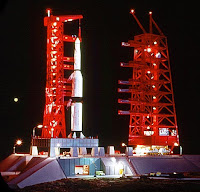I posted this article a while back, showing the slides from the View-Master Project Apollo set. Blog reader MJ on Southcoast Base spotted this cool treatment on Youtube which uses the twin cel images to create a neat volumetric faux-3d effect!

Long before the advent of mobile phones, or portable video, cine films and slides were the order of the day. Super 8 and Kodakchrome film would allow anyone to make their own home movies or slideshow. Toy companies saw a gap in the market for children's slide viewers and simple projectors or the Marx Flashy Flicker gun shaped model, allowed kids to run their own tiny cinema show, just for themselves or for their friends. 3D became a big draw in the fifties, with the audience having to wear bi-chromic glasses to get a 3d effect from the film and the victorians had earlier perfected the stereoscope, which used to images of the same subject taken at slightly different angles, which when viewed though a special mount, gave a faux 3d effect.
Two businessmen developed the idea of the early stereoscope and launched the 'View-Master' device at the 1939 Worlds Fair. Whereas the original stereoscope used to images at a time, the View-Master used special 16mm slides on a disc, 21 images in seven pairs. The user could press an advance lever to quickly move on to the next scene, with the stereo slides simulating the binocular effect and increasing the illusion of depth. The first View-Masters were marketed as 'scenic postcards' and sold via photographic suppliers and tourist gift shops. As the brand developed, it acquired the rights to use Disney cartoons and other famous children's series and the View-Master reached the hands of children.
Originally made from Bakelite, the simple viewer remained essentially unchanged, apart from moving to a lighter plastic version and adding the use of sound in more recent times. As a means to present a story for children it had the advantage over a book or a comic of being much more real and almost like a film and proved really popular.
With the advent of the space race, the factual and science series of reels naturally began to include space themed disks, one of the best being a 'Project Apollo - Man on the Moon' set. As it was originally released in the mid sixties, the imagery is largely based on the projected designs for the spacecraft, which were being put forth by the various engineering companies, eager to be first to the moon,
Early concepts for the LEM were much more streamlined and rounded, whereas the Apollo capsule remained more or less unchanged in basic shape.

























This is a fantastic View master set, which I got from the gift shop, on a school trip to the Jodrel Bank Radio Telescope, near Manchester, in the late 60s or early 70s.
ReplyDeleteThe methods used were Andersonesque, as in Captain Scarlet or Joe 90, and work really well. They were made by a married couple, who did other, more pre-scool, model sets for the View master range.
They remain my favourite Viewmaster reels to this day.
I think thats part of the attraction, they are a nice synthesis of Action Man and Anderson style dioramas. They still command good prices on ebay too! Im trying to get a good set of all the space ones in the series. Bill
DeleteA great set. I never had any of the Real Space View-Master sets. During WW2, View-Masters were used to help with aircraft identification training, along with real 3-D models, and flat silhouettes.
ReplyDeleteThe rugged lunar terrain seen in most pre Apollo paintings and film representations, was expected by scientists, as there is no atmosphere there, or oceans to weather the surface smoother.
ReplyDeleteHowever, they had underestimated the weathering caused by constant meteoric bombardment, over hundreds of millions of years, as well as heat and radiation deterioration, breaking up the surface rock and covering it in a layer of fine lunar dust.
Hence the actual surface, especially in the flatter areas, where it was safe for the Lunar Modules to land, is much softer looking and 'hilly', rather than craggilly mountainous.
Sorry, 'craggily'.
ReplyDelete